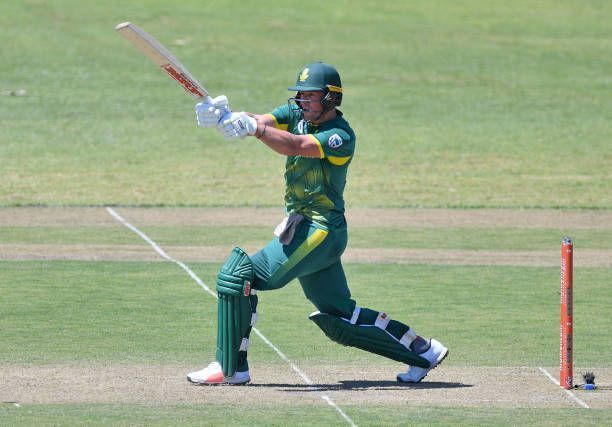
AB de Villiers Retires, but South Africa might not miss him in the World Cup 2019
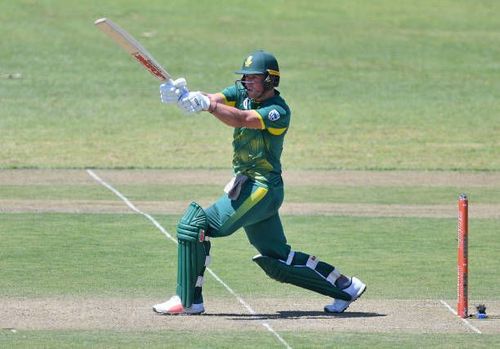
It was unexpected, unprecedented, and left everyone flabbergasted. It was a classic AB De Villiers move.
As a batsman, there are few things that de Villiers is incapable of doing. With the vast array of shots up his sleeve, it has almost become a norm for the cricketing world to witness him batting with disbelief. Over the past 14 years, de Villiers has brought in a revolution of sorts in world cricket. At a time when players concentrated on playing through the innings with classic, so-called textbook shots, de Villiers brought in the idea of a complete 360-degree batsman.
His silky footwork, the ability to pick out the intended delivery quicker than most of his peers, and the sheer elegance while batting coupled with brute force that sent deliveries way up the stands, de Villiers defied normal cricketing thoughts whenever he took the crease.
He was a revolutionary of sorts, someone who brought in the idea of unorthodox, yet effective batting at an age when the purists were reluctant to adapt to the new bunch of cricketers. Eventually, he attained a certain level of consistency and became the fulcrum of South African national cricket team too.
ABD is undoubtedly revered amongst the Proteas, and there are few cricketers all around the world who command the level of respect and love from opposition fans that he does. It has in a way, become impossible in the common cricketing society to talk about De Villiers’ drawbacks; he has few of them, lesser than others do, but they are glaring.
Despite having represented his country in five major ODI international events, the South African didn’t emerge victorious even once. Though it would be unfair to put the entire blame on a particular player, it wouldn’t be unfair to believe that de Villiers’ has failed to come out on top in the most important moments of these major tournaments.
Normal stats state that de Villiers possesses the second-best average in ODI cricket while chasing a target. He has recorded an average of 56.81 and strike rate of 95.04 whenever his team fielded first, which is impressive considering that he comes in to bat in the middle overs and has to dig deeper into the innings to secure a victory.
Only Virat Kohli, who averages an astonishing 67.20 in the second innings, exceeds his average. De Villiers’ strike rate while chasing a target is bettered only by the likes of Adam Gilchrist, Virender Sehwag and Shahid Afridi. It is interesting to note that all three of them were quite different to de Villiers in terms of batting style. Still, the South African managed to rise high amongst the lot to become, at least, statistically, one of the best players to chase down a total ever.
But, spare a thought and think, have the bilateral series’ ever been a worry for a country having the calibre of players like South Africa do? They have been one of the best sides while touring away from their home, and tend to give a tough competition to any side, potentially dismissing the home ground advantage that the opposition possesses too.
The South African national team, unlike others, has been prolific away from home too. Hence, these bilateral matches aren’t something that concerns them. It’s the big stage, the multi-nation tournaments in which South Africa struggle to find their feet properly. Often nicknamed chokers, albeit a bit too harsh, but it is not much far away from the actual truth.
The Proteas have always bottled under pressure, something that has harshly affected their chances of staking a claim at any major international trophy. Despite carrying a plethora of enviable talent with them, the team, more precisely some important players fail to click at the right moment. This has hampered their chances of winning any major trophy, and de Villiers has to take a huge chunk of responsibility for their constant underperformance in these big tournaments.
Something bugs the South African team and deludes them from crossing the finishing line. It is, after all, a game where players are defined with the amount of success that they achieve in multi-nation events. Quite similarly, something troubles ABD too. His performances whilst chasing a target might be delusional and deceptive; because, it diverts one’s attention away from how he coped with pressure and expectations whenever the team was struck in a do-or-die moment.
Hence, while referring to the stats over here, we discuss only the knockout matches from ICC World Cups. In reference to the Champions Trophy, it would be necessary to consider the group stage matches too, because the format of the tournament is such that there are no quarters or super-eights in it. The winning team ends up playing only five matches, and hence by referring to the group stages, I would have a bigger sample space to portray my opinion.
Here, the ICC Cricket World Cup 2007 is brilliant from my point of view, as the super eights segment tested a player’s and a team’s capability to proceed in the tournament in a much better way than the current format. Hence, ABD’s records from the super eights of the World Cup 2007 are also considered.
World Cup 2007:
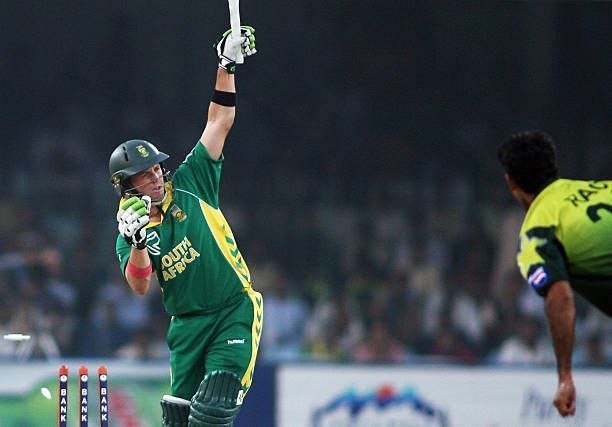
If 2005 was the year when ABD broke into the international scene, it was 2006 when he finally showed some good glimpses of his talents. In 12 ODIs in 2006, he scored 466 runs at an average of 42.36 and struck runs at 84.99 per hundred deliveries. Therefore, whilst entering his first major tournament, there were naturally a lot of expectations from.
Despite the fact that the team had one of the best batting lineups; with Graeme Smith, Jacques Kallis and Herschelle Gibbs in the ranks, de Villiers had the backing of one of the most experienced and talented batting orders. However, his form since the Super Eights to the semifinal exit was hardly satisfying, his form is cloaked due to a single century knock that he played against a West Indies team that has constantly been on a decline since the turn of the century.
However, as South Africa proceeded beyond the group stage, and the heavyweights such as India and Pakistan were already out, it was probably the best opportunity for the Proteas to have a startling run in the tournament. ABD started the Super Eights poorly, as he got out on successive ducks in the first two matches.
While chasing a modest 210 against Sri Lanka, he was bowled over by Chaminda Vass’ delivery. Later, Smith and Kallis played important roles in what turned out to be a tense chase. The second match was against a relatively weaker Irish side, and South Africa managed to win the match while chasing courtesy to Smith and Kallis again, who dug deep and snatched a victory from a rain-affected match.
The Proteas next suffered a shock defeat at the hands of Bangladesh, as Habibul Bashar’s team exploited the Africans’ weakness while chasing a total. ABD had another no-show this time, as he scored just 15 runs off 39 balls, and could not anchor the innings in the way Herschelle Gibbs did in the end. Nevertheless, South Africa lost the match by 67 runs, and de Villiers’ worrying form continued.
Despite all this, the team stuck with him to open the innings, something that he later relinquished in his career. His century knock against West Indies was a good show of pure swashbuckling hitting shots, but it could be argued that this one inning has cloaked his entire horrendous run in the busy, detrimental stages of the tournament. This time, against West Indies, South Africa were batting first and this obviously worked in ABD’s favour too as he had completely failed while chasing a target in the previous three matches.
Later, De Villiers was dismissed for a duck once again, this time against New Zealand, that too, while batting first. He rather redeemed himself against England, when he notched 42 runs off 35 balls whilst chasing 155 runs. Eventually, ABD did walk back to the pavilion, but it was a decent improvement from the previous encounters in which he was asked to open in the second innings.
However, as the stakes went high again in the semis, ABD was mediocre yet again, scoring just 15 runs off 34 deliveries at a strike rate of 44.11. Yes, the other players didn’t step up either; but, isn’t that what a temperamentally strong youngster needs to do? To take over the mantle from the seniors when they don’t perform accordingly? Smith and Kallis were dismissed for two and five runs respectively, but that does not excuse ABD of his lack of good form in any pressure situation throughout the tournament.
Virat Kohli played a superb, technically equipped knock of 35 runs, which had a huge impact in India’s final victory against Srilanka in the 2011 ICC World Cup. At around the same age, de Villiers struggled to keep good form and broke under pressure almost every single time he faced a difficult or tricky chase in the 2007 World Cup. Granted, he was a youngster and was still being drafted in the team; but well a lad needs to take up responsibility at such a crucial stage. Barring the first-innings century against an obviously weakened West Indian bowling attack, there were no glaring or notable contributions from his side.
Champions Trophy 2009:
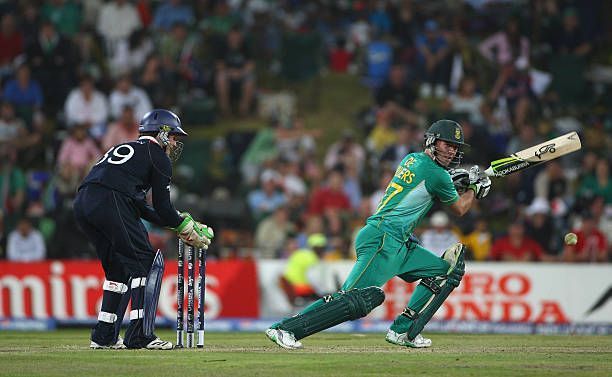
Now, as mentioned above, it is necessary to take the group stage matches of the Champions Trophy into consideration, as South Africa has failed to qualify to the semifinals of this tournament two of the three times in which de Villiers was part of the team. Also, the format of this tournament is such that every group match is almost a knockout one, as there is a lesser number of teams when compared to the World Cup and hence the teams are almost required to win two of the three matches to stand any chance of qualification.
ABD entered this tournament in an iffy run of form, as 2008 wasn’t a productive year as such for him from an individual perspective in ODIs. That year, he scored 434 runs in 12 innings, which included three half-centuries. It was a significant dip from his 1209 runs from 32 innings in 2007, but things had changed for him this time around, as compared to the 2007 World Cup.
In the Champions Trophy 2009, de Villiers was demoted to the number 4 position, which has its own significance in ODI cricket. As a middle-order batsman, he no longer had to face the new ball and was instead required to finish off innings as he mostly came to bat in the middle overs.
South Africa’s first match in the tournament, incidentally resulted in a loss, again while batting second. Sri Lanka was restricted for 261 runs, and it was a good bowling performance from South Africa, led by the enigmatic Dale Steyn. De Villiers came into bat when Smith’s wicket fell in the first ball of the 15th over. Though he got off to a decent start, by taking his time and scoring 24 off 38 deliveries, there was a non-assuring sign as he didn’t score a single boundary throughout his stay at the crease.
Eventually, he was undone by a Lasith Malinga delivery, caught by Mahela Jayawardene in the 27th over. He left while South Africa still had 120 runs to chase, and all the top five batsmen were back in the pavilion. It was a good start from his side, but the aspect of being the last specialist batsman, coupled with a rather indifferent boundary-less time at the crease meant that he failed to finish off what seemed to be a decent opportunity to register their first victory.
I would take a backseat now and give him all the credit for playing an excellent knock in the second match victory against the Kiwis. His unbeaten innings of 70 runs off 76 deliveries was a pure testament to his true class, character and displayed what he was capable of doing against a tough opponent in a pressure situation too. Sadly, he hardly ever replicated such an innings further in his career, but for now, let’s focus on this one particular match.
Dale Steyn and Wayne Parnell wrecked havoc against a good Kiwi batting lineup, with the latter claiming an excellent fifer and even stopping the Kiwis to 214 runs only. Though South Africa lost Smith early, ABD came into bat in the 17th over and eventually played a sensible knock with a strike rate of 92.10, something that eventually kept the team’s hopes of staying alive in the tournament.
This has to be my favourite ABD knock under pressure. However, this is kind of the limited ones in which he remained unbeaten throughout to emerge victorious in a high-pressure chase. Credit is must be given where it is due.
Now, having lost the first match, it was important for the Proteas to win the final game against England in order to bid for a semifinal berth too.
This can be labelled as one of the matches in which South Africa was pushed to their limits by England, as they were asked to chase a mammoth 324, owing to Owais Shah and Paul Collingwood’s brilliant half-centuries. Smith was leading the charge from one side, and when ABD arrived at the crease in the 12th over, he was just required to play an anchoring role as the captain was going berserk with his stupendous stroke play.
Unfortunately, ABD couldn’t continue further, as he was dismissed by Paul Collingwood in the 25th over itself. This time around, de Villiers did not even have to play the lead role in the chase, but well, his dismissal initiated a collapse of sorts, and Smith’s valiant knock of 141 runs went in vain.
South Africa eventually had to bow out of the tournament, and though ABD played a stellar knock against the Kiwis, he flattered to deceive in the other two games, which were equally detrimental to the team’s chances in the Champions Trophy. His dismissal was eventually the turning point in the match against England, as the Proteas looked well in the course to chase off a high total at their home ground. ABD again was unable to capitalize on a good start, something that a middle-order batsman should do consistently.
World Cup 2011:
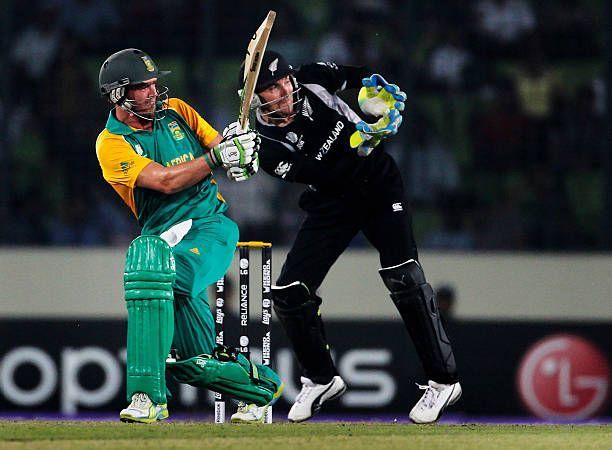
The format for this time’s World Cup was significantly changed, and the Super Eights were scrapped off. This meant that there were two groups, and each team played seven matches apiece. At the end of the group stages, the top four teams from each group would qualify for the last eight, which is called the quarterfinals. ABD had a fantastic 2010 calendar year, in which he scored 964 runs in 16 ODI innings and scored five centuries and 4 half-centuries too.
He eventually made it to the ICC ODI Team of the Year for 2010, and hence there are no apprehensions or doubts over the fact that he was entering the tournament on the back of a wonderful run of form. South Africa finished at the top ahead of favourites India in the group, and hence they had to face New Zealand, who finished at the fourth spot in the other group.
This was a relatively easy draw for South Africa, as New Zealand weren’t at their convincing best and the Proteas had the firepower to pave their way to the semifinals. The quarters was being played in a slow and sluggish Dhaka pitch, and a collective bowling effort from South Africa meant that New Zealand could only score 221 runs at the end of the fifty overs.
The Proteas would have fancied their chances to chase it off, but they lost Hashim Amla quite early in the innings. Smith and Kallis steadied the ship and added some vital runs, until the time when Smith got out in the fifteenth over. ABD took the strike and was busy between the wickets. He scored four boundaries and tried to stitch partnerships with Kallis and Duminy. When the latter two were dismissed within the span of three overs, it was all upon de Villiers to prove his mettle and to steer the chase.
The target wasn’t a lot, to be honest. He had to dig deeper into the innings, and had to carry the other players. It should be noted that by this time, de Villiers was fairly experienced and should have taken much more responsibility to ensure that his team chased off a really modest target. He even had Faf du Plessis and Johan Botha to accompany him, but a moment of madness in the 28th over resulted in ABD being run out by the duo of Martin Guptill and Brendon McCullum.
It was an end to his innings, and the team never fully recovered with Faf and Botha bowing out after garnering good starts too. At such an important situation, it was highly avoidable and just goes on to display the nervousness that de Villiers and the entire team carried. It was the perfect opportunity for ABD to keep a calm head, and to anchor a tricky chase. It simply didn’t happen in the end.
Champions Trophy 2013:
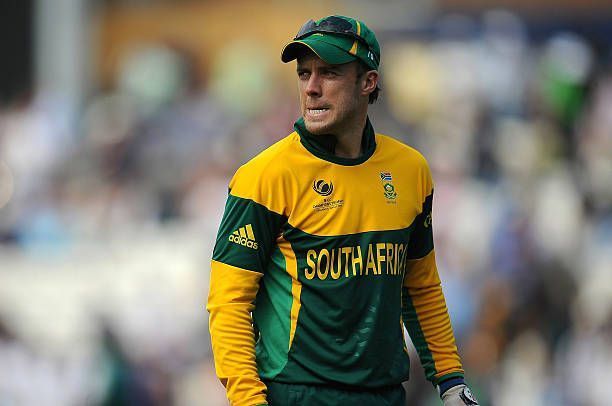
ABD was excellent in the years 2012 and 2013. While in 2013, he made it to the ICC ODI Team of the Year, in 2012, he actually boasted of an average of 107.50 in 12 innings, which included two centuries too. He had scored 645 runs, high scoring with 125 not out, but the average of 107.50 indicated that he was playing the course of fifty overs and hence he remained until the end of the innings. It was a good sign for the South African team, who had suffered previously when de Villiers did not finish the innings or stayed until the end during tough run chases. Unsurprisingly, the mood was uplifted going into the tournament.
South Africa had to face India in the first group stage match, and de Villiers surprisingly opted to bowl first. It was a weird move, considering the team’s consistently poor record while chasing targets in some big tournaments, and India somewhat made them pay for it too. Shikhar Dhawan scored a brilliant century, and Ravindra Jadeja played a quick inning of 47 runs propelled India to score 331 runs at the end of fifty overs.
The Proteas did not start well, as Colin Ingram fell early and Hashim Amla went after scoring 22 runs. Robin Peterson and ABD stitched a decent partnership of 124 runs. De Villiers counter-attacked and put India in the back foot, as South Africa seemed to be pulling off a great run chase. Soon after they settled well, Peterson was run out due to a quick piece of fielding by Jadeja and Dhoni. Peterson was involved in a mix-up in the middle, and the pressure fell on de Villiers now to stay till the end. He completed his half-century and struck 70 runs off 70 balls.
However, Dhoni introduced Umesh Yadav for another spell, and Yadav got ABD out quickly, with a catch off Jadeja on point. Despite having played a remarkable knock, de Villiers was dismissed at a vulnerable stage of innings. At the time of his dismissal, the team still required 167 runs to attain victory, and that considering that he was the fifth wicket that fell for the Proteas, it is visible that they weren’t in a stage to comeback after that.
De Villiers was the only hope, through which they could have claimed a victory. The innings kind off collapsed after that, though Ryan McLaren played a valiant knock of 71 runs despite not being a specialist batsman. It was yet another case of ABD failing to keep the innings on track, despite having settled well into the crease.
Since the time he was asked to play in the middle order, ABD has had to carry more initiative while batting. It is because of the fact that the South African innings always looks to derail once he gets out in a delicate situation.
The match against Pakistan was a peculiar one as the Proteas seemed to have learned from their mistake and decided to bat first. Hashim Amla played a patient knock of 81 runs, and that helped the team post 234 runs. ABD scored 31 runs off the same number of balls and went out in the 41st over courtesy a run out affected by Misbah-ul-Haq. His dismissal meant that the batsmen failed to keep hold of the innings afterwards and they could score just 48 runs in the next nine overs, losing five wickets in the process.
Another clear indication of the fact that the Proteas were dependant on de Villiers in the middle order, and how vital a cog he was in that batting order.
They were bailed out with some effective bowling by ABD’s team, as Ryan McLaren took four wickets and Pakistan was bowled out at just 167 runs.
Next up was the match against West Indies, and Dwayne Bravo’s team did a great job by restricting South Africa to just 230 runs. ABD promoted himself to the number three position this time around and looked to counter-attack brilliantly. He played with a strike rate of 142.30 and scored a quick 37 runs at just 26 deliveries. Ravi Rampaul dismissed him, but the points from this match were shared as neither side could achieve a decent result, as this was a rain-affected game. This one point ensured that ABD’s team proceeded to the semifinals, and hence they were prepared to play their biggest and most important game in ODI cricket since the semifinal loss to Australia in the 2007 World Cup.
De Villiers’ rotation in his batting order continued in the semifinals too. Having been put to bat first against England, it seemed to be a tailor-made situation for South Africa. They had struggled in run-chases, but things started going awry for them as soon as the innings begun. Colin Ingram and Hashim Amla gave a poor start, as James Anderson and Steven Finn dismissed both of them within the first two overs respectively.
Robin Peterson and Faf du Plessis brought some stability, but Peterson was caught leg before wicket by an Anderson delivery and hence ABD came into the crease in the 11th over. This was another huge opportunity for him to play a sensible, important inning in a knockout match. The innings was fairly balanced after a forgettable start and de Villiers had a decent base to build upon his partnership with Faf.
After playing eight deliveries without scoring a single run, de Villiers was caught by Jos Buttler through a delivery by Stuart Broad. It was another disappointing outing for the captain, and the team could score only 175 runs in the end. It wasn’t an unplayable pitch of sorts. David Miller and Rory Kleinveldt scored 56 and 43 runs respectively, despite playing way down in the batting order.
It just shows that the batsmen had to apply themselves perfectly, and after coming in to bat the number 5 slot, de Villiers surely had to chance to build up his innings without taking any risks. He did not do so, and South Africa crashed out of another major tournament in the knockout stages.
ABD and South Africa’s direful form in such do-or-die matches continued.
World Cup 2015:
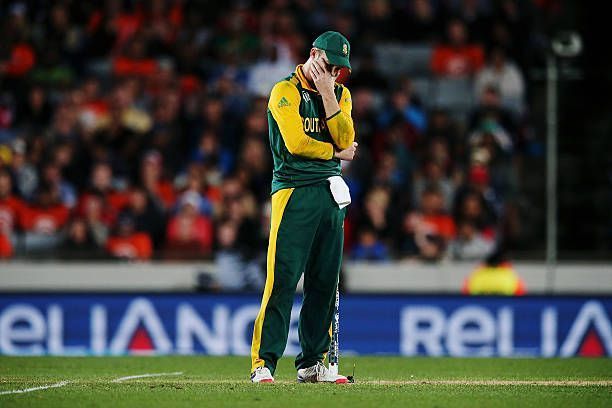
This World Cup saw an excellent inning from ABD when he slaughtered the West Indian attack to score 162 runs off just 66 deliveries at an unreal strike rate of 245.45. South Africa eased their way to the quarters barring a single defeat against India, in which, ABD was run out after scoring 30 runs in 38 balls while chasing.
He was included in the ICC ODI Team of the Year in 2013 and 2014, and hence there’s no sign of poor form from his side. In the quarterfinals against Srilanka, a brilliant four-wicket haul from Imran Tahir meant that Angelo Matthew’s team was bowled out at just 133 runs. Later Quinton de Kock top-scored with 78 runs and South Africa easily chased the total in 18 overs.
ABD didn’t have to bat this time around as the Proteas lost just a single wicket in the run-chase. In the semis, ABD ably supported Faf and later accelerated the innings as they were batting first. De Villiers scored 65 runs off 45 balls, and it was a good knock from his side as South Africa went ahead to score 281 runs in just 43 overs.
It was a rain-affected match and hence ABD’s quick innings was crucial, considering that the DLS could have come to use too. He attacked the Kiwi bowlers and took the optimum advantage of the small grounds by scoring eight boundaries and one six in his short, crisp yet entertaining and effective innings. It has to be one of the best performances that we have seen from de Villiers, as he was undeterred by the magnitude of the match, and simply went about his business.
This is not something that we have seen from him consistently throughout his career, but this inning deserves a special mention as de Villiers was at his absolute best. South Africa’s good efforts with the bat were undone with professional displays from Brendon McCullum and Grant Elliot. There were many fielding errors, with de Villiers comically messing up Corey Anderson’s run out when the Kiwi had scored 34 runs.
Anderson later went on to add up 24 runs more to that tally and was dismissed only in the 38th over, with the game having shifted to New Zealand’s favour by then. Lack of patience and calmness under such situations was clearly visible, as a player of de Villiers’ calibre, who is capable of pulling off the most unthinkable of catches hardly ever misses such run outs.
Other fielders made such fielding errors too and they eventually bottled up what could have been an ideal match for them to safely qualify for their first ever finals appearance.
De Villiers was good with the bat, but, not so much with his captaincy or fielding, and it did hurt his team in the end. However, credit is there where it’s due and hence his 65 runs knock was indeed special and crucial for the team to deliver a fighting performance in the end.
Champions Trophy 2017:
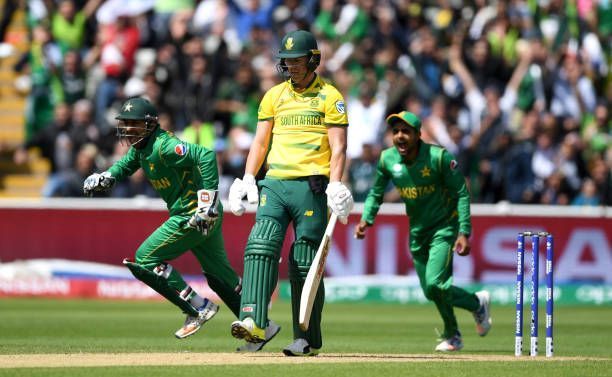
Now, we come to the tournament, which I believe is the catalyst behind ABD’s rushed retirement from international cricket. He made it into the ODI Team of the Year continuously from 2013-17 and hence, naturally, there was no significant dip in his form in the past five years. Heading into the 2017 Champions Trophy, South Africa were in the same group such as India, Pakistan, and Sri Lanka. Undoubtedly, they were expected to proceed to the semifinals as Pakistan and Srilanka were hardly convincing throughout the build-up to the event.
South Africa won their first match against Srilanka convincingly, as Hashim Amla’s injury helped them post 299 runs. Barring Amla, Du Plessis and JP Duminy played sensible innings’ too. Amidst this, de Villiers scored four runs off six deliveries as he Seekkuge Prassana’s leg-break ensured that he couldn’t impose his impact in the game. ABD went back to the pavilion early, but South Africa won the match due to a professional performance from the rest of the team.
In the second match against Pakistan, ABD opted to bat first and came in to bat in the 14th over at number 4. This time, Imad Wasim got better of de Villiers in the first ball itself as ABD got out for a duck, as his disappointing form continued again. Miller, Morris, and Rabada rescued the innings later on, but Pakistan chased the target due to Sarfaraz Khan’s stellar knock in the second innings. ABD now had failed in two important matches, and this made the encounter against India a do-or-die match for both the teams.
India elected to field first and gradually were frustrated by the resilience of South Africa’s opening partnership as it took as long as the 18th over to claim their first wicket. However, de Kock and Amla had provided a stable base for the middle-order batsmen to build their innings on. The new ball was seen off and there were almost 80 runs on the board.
Though the run rate was less, it could have been covered up with some smart batting in the middle overs. Faf tried to stabilize the innings, and de Villiers scored just 16 runs off 12 deliveries, getting run out yet again in a match of such high magnitude. He was dismissed in the 29th over with 140 runs on the board.
Eventually, South Africa would go on to make just 51 runs in the next 16 overs, losing seven wickets in the process. India successfully chased the target in 38 overs without much fuss, and lack of temperament, character, patience, and calmness while batting for South Africa hurt them sorely.
ABD ended the tournament with just 20 runs from three crucial matches, which had a huge role in halting their further progress in the event. Such underperformance was unexpected from a captain and a player with his talent and experience.
However, think for a while, “Was it really unexpected?”
ABD has represented his country in six major tournaments and has been equally guilty of not rising up to the expectations of the entire country. South Africa loses their composure in such pressure-filled situations and ABD was no different to the other players in this regard. With the twenty hugely important matches that I took into consideration, he changed the course of the match and bailed the team out in very few matches.
Probably the second match in the group stage against New Zealand in the Champions Trophy 2009 will be the only exception to this fact.
You can accuse me of cherry-picking ABD, but the fact that he was the best batsman in the team by a long distance means that he had to take more responsibilities. That is what a captain or an experienced player is supposed to do.
ABD was an excellent entertainer, who enthralled the world audience with his enviable stroke-play and innovative shots. However, when it comes to high-pressure situations or the knockout matches, ABD was hardly different from any of the other South African player. He too bottled under pressure and was unable to keep his usual composure as visible from that missed run-out opportunity of Corey Anderson in 2015.
It is clear that the South African batting lineup always seemed to collapse after de Villiers’ departure. Thus, his inability to finish off matches, or anchor an innings in difficult situations is startling considering the amount of his importance that his wicket carried. In my above analysis, it is clear that ABD never entered a huge tournament with the back of a dismal run of form. His performances while going into these events were always strong, and he regularly featured in ICC’s Team of the Year too.
Hence, I believe that his absence will not be felt in the 2019 World Cup, as his recent performances in the Champions Trophy, as well as the numerous mediocre displays in do-or-die games over the years, suggest that the Proteas will have someone better equipped than him to deal with such crunch moments.
I do not try to demean ABD as a player, as there were few batsmen who made cricket look more enjoyable than him. His legacy, as a player, will continue to inspire countless aspiring cricketers.
However, in the above-mentioned scenarios, his performances and displays hardly differed from any other South African cricketer.